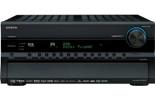Onkyo TX-NR905 AV Receiver
Overview -This article has been abridged and updated from an original review on HDD's sister-site www.AVRev.com
IntroductionThis THX Ultra2-Ccrtified 7.1 multi-channel receiver offers a plethora of standard and high-definition audio decoding formats, including Dolby Digital, Dolby Digital EX, Dolby Digital Plus, Dolby TrueHD, Dolby Pro Logic IIx, DTS-ES Discrete, DTS-ES Matrix, DTS-HD Master Audio, DTS-HD High Resolution Audio, DTS 96/24 and DTS Neo:6. Additional algorithms include Neural Surround, THX-Neural, DSD Direct and Onkyo’s proprietary Theater-Dimensional virtual surround sound mode.
In addition to offering ample audio and video connectivity, the TX-NR905 also has an Ethernet interface for accommodating a variety of networking capabilities. Furthermore, Onkyo incorporated the extremely sophisticated Audyssey MultEQ XT room measurement and correction system, allowing for automatic optimization and equalization of the audio system. Not to be overshadowed, video sources are managed by Silicon Optix's highly regarded Reon-VX HQV 1080p video processing chip, offering powerful video processing and up-conversion capabilities.
The TX-NR905 is HDMI 1.3a-compatible, including internal decoding for DTS-HD, Dolby TrueHD and Dolby Digital Plus. Featuring a sophisticated set of internal video processing capabilities, Onkyo’s TX-NR905 is the world’s first A/V receiver to incorporate HQV Reon-VX video processing. It provides extensive video connectivity including three high-resolution component video inputs, along with one output. HDMI 1.3a 1080p-compatible connectivity consists of four inputs and two outputs, allowing good video flexibility for an A/V receiver. All video inputs are upscaled to 1080p over the HDMI connection. Additionally, all non-HDMI video sources will be up-converted to HD output via the unit’s component video outputs to accommodate video displays lacking an HDMI input.
The TX-NR905 has a published rated power output of 140 watts minimum continuous power per channel into an eight-ohm load, two channels driven from 20 Hz to 20 kHz, with a maximum total harmonic distortion of 0.05 percent (FTC). Onkyo achieves these ratings by using their High Current Power Supply (HCPS) transformer for all audio outputs, and additionally supplies two separate transformers for audio and video processing to isolate the power requirements for their different functions and circuitry.
Further improvements to the amplifier were achieved through two of Onkyo’s new proprietary technologies, Vector Linear Shaping Circuitry (VLSC) and Wide Range Amplifier Technology (WRAT). The inclusion of VLSC is reported to reduce digital pulse noise compared to conventional digital-to-analog conversion methods. A smooth output waveform is produced by sampling between discrete data points and joining these samples with analog vectors in real time. WRAT is a collection of technologies that improve frequency response and output signal integrity at increased volumes. The inclusion of Burr-Brown 192kHz/24-bit digital-to-analog converters for all channels further enhances the performance capacities of the TX-NR905.
In addition to a standard, full-featured AM and FM analog tuner, the TX-NR905 also includes a built-in digital HD radio tuner, as well as XM and Sirius radio connections. The HD radio features text data display with multiple presets. XM and Sirius satellite radio access is possible with the optional XM mini-tuner and home dock, and a SiriusConnect home tuner kit. Both satellite radio services offer extensive station search and tuning choices with comprehensive receiver display information options. Subscriptions are required for both satellite services in order to enable these features and functions.
Set-upMy initial experiences with the TX-NR905 went without incident, as the set-up was relatively intuitive regarding its basic set-up functions. Configuring the audio and video inputs, speaker distance and amplitude settings, along with other general system configurations, was all completed without having to defer to the owner’s manual. It was with these settings that I conducted my preliminary listing tests to see how the unit performed with the manual configuration, excluding the Audyssey MultEQ XT auto-calibration and room correction functions.
During my initial evaluations, the TX-NR905 was utilized in a variety of two-channel and multi-channel configurations, with the primary speakers being either my reference Revel Salon multi-channel system, or PSB’s Synchrony. Speaker positioning was fairly conventional, with both speaker systems being positioned approximately nine feet apart, four feet off the back wall and three feet away from the sidewalls. The center listening location is approximately 10 to 11 feet from the speakers, depending on the positioning of the listening chair.
After the preliminary assessments were made, it became quite evident that a complete review of the owner's manual was in order. There are countless ways of configuring the TX-NR905 for both audio and video, and it is essential to understand how to implement each of the settings to optimize the performance for your home theater system.
The audio system can be configured manually by setting each loudspeaker’s crossover frequency independently to 40 Hz, 50 Hz 60 Hz, 70 Hz, 80 Hz (THX), 90 Hz, 100 Hz, 120 Hz, 150 Hz, 200 Hz or full range. Also, the receiver has a built-in seven-band graphic equalizer, with bands centered at 63 Hz, 160 Hz, 400 Hz 1000 Hz, 2500 Hz, 6300 Hz or 16000 Hz for the main loudspeakers, and 25 Hz, 40 Hz, 63 Hz, 100 Hz and 160 Hz for the subwoofer, all adjustable in 1dB increments. This gives you the ability to modify the overall sonic characteristics of the system.
With the assistance of AVRev.com associate Dr. Christopher Zell, my next endeavor was to incorporate Audyssey MultEQ XT system calibration and room correction. Primary functions are to automatically measure the number of speakers connected to your system, their low-frequency reproduction capabilities, optimal crossover points and their relative distances from the primary listening location. Using the supplied calibrated microphone, eight measurements were taken, with critical attention given to recording exact distance measurements regarding microphone placement for each individual calibration test. With the introduction of room correction, it becomes equally possible to improve or degrade the performance of an audio system by the manner in which the measurements are extracted. I would recommend keeping comprehensive notes while taking your measurements, so that you can duplicate the room correction settings as needed. This said, the first results incorporating the Audyssey room correction settings were less than desirable. It took several attempts, utilizing the maximum eight measurement samples, to achieve uniformly improved results throughout the entire frequency range and listening area.
After the initial set-up was complete, it became very apparent that there were discrepancies between the TX-NR905 Owner’s Manual and the actual menu screens that were displayed through the monitor outputs. I was unable to find any information or menus that would allow adjustments for basic video control functions such as contrast, brightness, color saturation, hue, etc., yet the TX-NR905 possesses such functions. By navigating a sequence on the remote control, a menu is accessed that allows for such adjustments. The menu is only visible on the display window of the TX-NR905.
I engaged the Silicon Optix Reon-VX processing within the Onkyo for both the front-projection (Optoma HD80 1080p single-chip DLP) and flat-screen (Pioneer Kuro PDP-5010FD 50 inch 1080p Plasma) displays. In both cases, HDMI connections were used, with any necessary up-conversion to 1080p performed by the Onkyo. Although the two displays were physically in separate locations in my evaluation, the TX-NR905 has two HDMI outputs that can be connected if necessary, although only one of them can be active at a time. This chipset provides the ultimate support for de-interlacing of both standard and high-definition signals, for 1080p reconstruction of film sources, for filtering of jaggies and artifacts, and for the reduction of random, mosquito and block (codec) noise. It also enables color region enhancement and the rendering of more than one billion colors.
Overall, I was especially impressed with the Onkyo’s video processing and upscaling, with one minor logistical exception. All changes to video parameters, such as saturation, brightness, etc., are global, rather than separate for each input, which can be inconvenient.
Music and MoviesDuring my initial evaluation of Onkyo's TX-NR905, a variety of two-channel and surround sound material was auditioned, including MP3 files, Redbook CDs, multi-channel audio discs and various concert and movie DVDs. The Onkyo proved to be extremely competent during stereo playback, and equally excelled with multi-channel material. Sans any of the equalization or room correction capabilities, the TX-NR905 performance was textbook, equivalent to other high-quality two-channel components that I have recently used. Whether I was cranking my favorite tracks off singer-bassist Me'Shell NdegéOcello’s Peace Beyond Passion (Maverick) or enjoying the self-titled DVD-Audio version of Toy Matinee (DTS Entertainment), the TX-NR905 rendered each track accurately, exhibiting excellent low-level detail, extremely linear frequency response and authoritative dynamic range.
Obviously, engaging the Audyssey MultEQ room correction function substantially alters the criteria for evaluating the resulting overall sonic attributes of the playback system. Improvements or degradations to the overall sound quality are equally possible, depending upon the diligence of your calibration set-up. As noted earlier, the multiple attempts made to achieve the best results using the Audyssey MultEQ provided a universal improvement to both the stereo and multi-channel sound reproduction. Most notable was the cohesiveness of the lower octaves, with Audyssey identifying and correcting any existing room resonances.
This improvement was extremely evident during my playback of a two-disc DVD drum concert of Virgil Donati’s Live in Stockholm. Donati's percussive virtuoso is a real torture test for any multi-channel system. The speed and intricacy with which Donati plays often get congested and become ill-defined with an inadequately tuned system. After engaging the properly calibrated Audyssey system filters, the overall reproduction of the performance was globally improved. Articulation, attack and delineation of Donati’s percussive extravaganza were simply awe-inspiring, and the speed at which he plays was hypnotic. Uniformity of frequency response was clearly improved through the audio processor, and sense of space and placement of each individual drum and symbol were easy to delineate.
Like the audio set-up, overall video quality will be largely dependent upon the thoroughness given to the calibration of the TX-NR905’s onboard Silicon Optix Reon-VX HQV video processor, along with your video display. Again, with the wide range of video processing and adjustability, there exists equally the ability to improve or degrade the overall visual performance. While viewing standard DVD movies and concerts, I enjoyed a discernible improvement in both resolution and picture quality by processing the discs through the TX-NR905’s Silicon Optix Reon-VX processor.
While viewing the HD DVD of Clint Eastwood's Oscar-winning film Unforgiven (Warner Home Video), I was able to evaluate the performance of both audio and video reproduction as processed through the TX-NR905. The Dolby Digital soundtrack was proportioned correctly in the context of the movie. Outside of a few gunfight sequences, the soundtrack was supportive of the visual cues in the movie, with TX-NR905 providing good sonic localization and clean, intelligible dialogue. The surrounds were sensibly used and engaged at the appropriate times. Throughout the movie, it seemed as if the walls of my listening environment had disappeared and I was surrounded by open space. In the torrential downpour scenes, spatial clues delivered by the TX-NR905 evoked the sensation of being surrounded by the pouring rain. Visually, the video through my projector varied depending upon the calibration. When optimized, it was easy to delineate visual details of the vast scenery that is present throughout this western tale. In bright scenes, images were sharp and natural-looking, especially during the close-up shots of the characters.
The HD DVD version of King Kong (Universal Studios Home Video) proved to be extremely satisfying and entertaining with the TX-NR905 at the helm. The audio reproduction of this film was substantially more active and engaging than it had been on previous editions; it was able to keep its composure even at high volumes. With the audio properly calibrated, micro-details of the soundtrack emanated from every corner of my listening environment. With a reduction of the room's resonant peak, low-frequency articulation and quality were greatly improved. One of the standout improvements of implementing Audyssey MultEQ XT is the retrieval of undecipherable audio cues that become startlingly clear and evident when the loudspeaker system is properly calibrated and corrected to the listening environment. Even with the computer-generated sequences, King Kong proved to be quite stunning visually. Unlike Unforgiven, the vividness and saturation of color throughout the film wee quite eye-popping. Detail and saturation of the green foliage throughout the jungle scenes was impressive, offering a lifelike, three-dimensional quality to the picture.
The DownsideThe Onkyo TX-NR905 was not without its faults. One of these might be insurmountable for some potential purchasers. Thermal management for the heat that is produced by the TX-NR905 will be difficult to control for those who desire or require that their equipment be placed in a restricted area behind closed doors. Although this multi-channel receiver has been engineered to operate at higher temperatures, other associated components quite possibly have not, and may malfunction if the ambient temperature in which they operate becomes too high. I would highly recommend placing the TX-NR905 outside of any restricted space, but if it is to be installed in an enclosed cabinet, appropriate ventilation should be incorporated. Please be aware that simply placing a fan by the unit without having sufficient air exchanges will not reduce the temperature within the enclosed equipment area.
As with many newer electronic devices using HDMI interconnections between various components, the Onkyo TX-NR905 did have some synchronization problems at times. I was unable to identify the exact cause of the issue, which prompted a call to Onkyo technical support. After I was given directions to reboot the TX-NR905, the unit worked within specifications and I had very few problems getting all of my HDMI-equipped components to interface correctly.
Unfortunately, I had other set-up questions that required additional communications with Onkyo’s technical support department. My next four efforts were less than successful. After being left on hold, which varied from 40 minutes to over an hour, I was finally able to speak with a representative, first providing my name and call-back telephone number, and begin to discuss the issue. Within a few brief moments, I was disconnected, and subsequently never did receive a single return call from Onkyo's technical support. This experience proved to be extremely frustrating, and I was required to use methods other than Onkyo’s customer support to acquire the information necessary to rectify the issues.
ConclusionSit down and do the math, and it becomes obvious why the TX-NR905 with its accompanying feature set at its asking price is an outstanding value. Onkyo has provided an extremely sophisticated audio/video component with numerous advanced processing features. It is extremely versatile and has abundant power to be the foundation piece of a truly high-end home theater and audio system. Although not without its shortcomings, and complex by nature of its flexibility, Onkyo still sets a new benchmark for quality and performance, challenging most audio/video receivers anywhere close to its price point. With its well-groomed aesthetics and solid build quality, incorporation of state-of-the-art audio and video processing, and most of all excellent global performance, it provides an exceptional value. The Onkyo TX-NR905 undoubtedly will be pursued by a wide customer base that is looking for a formidable receiver as the anchor for a compelling, exhilarating reference home theater system.












